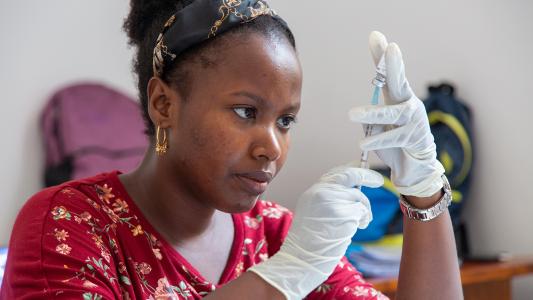The digital revolution has transformed how we access and discover TV, film, and music. In the art world, however, not much has changed since the 19th century.
Why? That was one of the questions Carter Cleveland asked more than a decade ago when he was conjuring up plans to create Artsy, the world’s largest online art marketplace.
“You’ve got Netflix for film, you’ve got Spotify for music, but there wasn’t a single platform that made all the world’s art accessible to anyone,” Cleveland, founder and CEO of Artsy, told Freethink.
Watch the full video on Artsy:
Founded in 2009, Artsy is now the world’s largest online art marketplace, hosting a collection of more than 1 million original artworks from artists both famous and emerging. Artsy functions not only as a digital auction house, but also as a digital museum, offering high-definition photos of each piece of art that users can examine up close. And depending on what art users like, the platform can recommend works from other artists whose work is similar in some way — just as Spotify is able to recommend music.
But unlike Spotify, the success of Artsy came not from a desire to disrupt a well-established industry, but to work with and expand it.
Rethinking an age-old industry
Having grown up visiting galleries and museums with his family, Cleveland knew that galleries often serve as the link between artists and collectors, helping to establish social relationships and curate artists’ work. Galleries also have loyal followings: clients and collectors who trust the taste of the gallery and regularly check their exhibitions.
“Our approach was instead of saying, ‘Hey let’s replace these galleries,’ we really said, ‘Where is our unique value at in an existing ecosystem that’s already creating lots of value?’” Cleveland said.
The first step for Artsy was to pitch galleries the business idea: Allow the company to virtually host the artworks that the gallery is exhibiting on Artsy.net, through which buyers anywhere in the world can connect with the gallery to discuss buying the art.
Cleveland initially thought the best strategy was pitching smaller galleries. But he quickly found that none of them were interested in teaming up with the platform until bigger, more established names were on board.
So Artsy went to the top of the food chain by meeting with Gagosian and Pace, the two biggest galleries in the world. Rather than pitching an online marketplace for art, Cleveland pitched them the future of the industry, as Artsy saw it.
“We are strong technology people, we understand the internet, and if you believe that the internet is the future of your industry, work with us and help us actually create that future,” Cleveland told Freethink.
Gagosian and Pace agreed to join Artsy. With the largest galleries secured, the rest fell like dominos: Artsy now has more than 3,400 gallery partners from over 100 countries on their platform.
What galleries were missing was the open access of the internet. They were limited to the public around them and collectors willing to travel. Cleveland aimed to change that, but he needed a technical solution to searching for art online — something to classify and catalog art.
In order to do that for more than 1 million works of art, Artsy needed a proper database and search technology for users to find what they were looking for. Leaning on his computer science background, Artsy started building the Art Genome Project.
Bringing the gallery experience online
Classifying the characteristics of art – things like artists, historical movements, and subject matter – is a monumental task. The Art Genome Project accomplishes this through more than 1,000 characteristics (also called “genes”) that power Artsy’s search engine, which recommends art based on searches across all of its known genes.
The project was modeled on Pandora’s Music Genome Project. Designed to recommend music to users, it emulates a radio DJ creating a playlist of complementary music. In this case, the Art Genome Project emulates walking through a gallery. Anyone can view art on Artsy and follow the genes tagged to it, encouraging discovery in the way someone could stroll through a gallery and notice shared themes and motifs across artworks.
In effect, the Art Genome Project allows Artsy to function like a meta-gallery, providing an online gallery experience for users. But for smaller artists not partnered with galleries, the Art Genome Project also grants exposure because they could be associated with other (more famous) artwork based on their characteristics.
“Our mission isn’t to take a dollar from you so there’s a dollar for me,” Cleveland said. “It was, how can we expand the overall market? How can we make it more accessible so more collectors can actually be a part of it, so more artists can get paid?”
On a broader scale, online-only art businesses seem to be on the rise. A 2021 Artsy report from Artsy surveyed 1,758 art businesses across 97 countries, finding that the total share of online-only art companies in the industry had doubled from 2019 to 2020, an increase that likely stemmed in part from COVID lockdown measures. It seems there’s a chance that shift could be permanent, based on the findings of the company’s 2022 report:
“Of the galleries we surveyed, 64% reported that their volume of online sales increased in 2021 compared to 2020, quelling doubts that online sales models would be temporary measures.”
For Cleveland, a major reason why Artsy succeeded was its focus on expanding the well-established art industry instead of disrupting it. On the business side, he noted that gaining partners and investors is easier when you approach the project with a genuine love and respect for the industry you’re seeking to innovate.
“People, and partners, and the resources of the universe come to your aid when you’re fully aligned with something that is in service of the greater good,” Cleveland said.






